Book contents
- Frontmatter
- Contents
- Notes on contributors
- Foreword
- Acknowledgments
- I Principles, practices, and theory
- II Programs
- III Learners and users
- 12 Understanding the learner at the Superior–Distinguished threshold
- 13 Preliminary qualitative findings from a study of the processes leading to the Advanced Professional Proficiency Level (ILR 4)
- References
- Index
13 - Preliminary qualitative findings from a study of the processes leading to the Advanced Professional Proficiency Level (ILR 4)
Published online by Cambridge University Press: 03 December 2009
- Frontmatter
- Contents
- Notes on contributors
- Foreword
- Acknowledgments
- I Principles, practices, and theory
- II Programs
- III Learners and users
- 12 Understanding the learner at the Superior–Distinguished threshold
- 13 Preliminary qualitative findings from a study of the processes leading to the Advanced Professional Proficiency Level (ILR 4)
- References
- Index
Summary
Most of the chapters in this volume focus on the practices of language teaching at Levels 3 (Professional Proficiency) and 4 (Advanced Professional Proficiency); a few focus on theory of language learning at this level. This chapter takes a slightly different direction; it reports on the purpose and nature of a highly comprehensive examination of the processes involved in achieving Level 4 (Distinguished or Advanced Professional Proficiency) and higher levels of proficiency that is being conducted through the joint efforts of the National Foreign Language Center (NFLC) and the Defense Language Institute (DLI). The researchers have interviewed in great depth language users at several US government agencies and in academia who have developed one or more language skills to Level 4 and beyond and asked them what did and did not help at various points in their language-learning careers. The purpose of the investigation is to examine the nature of Level-4 language from the perspective of those using it in their daily and professional lives, to assess the behavioral aspects associated with Level-4 proficiency, and to determine the most important factors that contribute to reaching that level.
The NFLC-DLI Superior/Distinguished Language User Study began in July 2001, is still in progress, and the full range of conclusions possible will not be available for some time. While it is too early to report definitive results, some trends do emerge from the data.
- Type
- Chapter
- Information
- Developing Professional-Level Language Proficiency , pp. 260 - 279Publisher: Cambridge University PressPrint publication year: 2002
- 11
- Cited by



